
What’s the Difference Between Ball Lock Kegs and Pin Lock Kegs?
Ball Lock Kegs vs Pin Lock Kegs – What’s the Difference?
The containers we call Ball Lock and Pin Lock Kegs come from the soda industry. Also called Cornelius Kegs, Corny Kegs and Corney Kegs, they were originally intended to store and distribute soda pre-mix. The big soda companies decided on different style containers for their pre-mix. Pepsi landed on the Ball Lock style while Coke uses the Pin Lock style.
Homebrewers have since re-purposed these as homebrew beer kegs.
Announcing: NEW Pin Lock Kegs Now Available!
 The availability of of used kegs has recently become an issue. See: Are Used Kegs Running Out?
The availability of of used kegs has recently become an issue. See: Are Used Kegs Running Out?
This has been especially true of pin lock kegs, because new pin locks have not been coming on the market. To my knowledge no new pin lock offering was generally available to homebrewers. This has caused the price and availability of pin locks to be a serious issue. For example, MoreBeer’s Pin Lock offering has sky-rocketed to $85 per keg.
Well, today is a happy day… Announcing NEW Pin Lock Kegs from cornyieg.com
- CORNY KEG 5 GALLON PIN LOCK KEG – SS
- CORNY KEG 5 GALLON PIN LOCK KEG – SS – 2 PACK
- CORNY KEG 2.5 GALLON PIN LOCK KEG – SS
- CORNY KEG 2.5 GALLON PIN LOCK KEG – SS 2 PACK
- 3 GALLON PIN LOCK KEG – SS
First, It’s important to understand both do the same thing with slightly different and dimensions and features. Note: All measurements in this post should be considered approximate. There are different models and manufacturers of kegs. Their sizes are generally about the same, but some kegs and manufacturers vary slightly. There are several sizes of kegs available including 2.5, 3, 5, 10 and 15 gallons. This post focuses on the commonly used 5 gallon size.
 The first thing you’ll notice is dimensions – Pin Lock Kegs wider than Ball Lock kegs. Ball Lock on Left, Pin Lock on Right.
The first thing you’ll notice is dimensions – Pin Lock Kegs wider than Ball Lock kegs. Ball Lock on Left, Pin Lock on Right. Left [Brand New 5 Gallon Ball Lock from AIH – Review] | Right [Used 5 Gallon Pin Lock] – Pin Locks are also shorter than Ball Lock Kegs. Ball Lock on Left, Pin Lock on Right. Both of these kegs have a ~5 gallon capacity.
Left [Brand New 5 Gallon Ball Lock from AIH – Review] | Right [Used 5 Gallon Pin Lock] – Pin Locks are also shorter than Ball Lock Kegs. Ball Lock on Left, Pin Lock on Right. Both of these kegs have a ~5 gallon capacity.
Limited Time Keg Deals, Article Continues Below:
kegdeals
This article contains affiliate links. We may make a small percentage if you use our links to make a purchase. You won’t pay more and you’ll be supporting Homebrew Finds and more content like this. Thank you for your support!
 The Pin Lock Keg is about 2.5″ shorter than the Ball Lock Keg
The Pin Lock Keg is about 2.5″ shorter than the Ball Lock Keg Top down view. Ball Lock on top, Pin Lock on bottom
Top down view. Ball Lock on top, Pin Lock on bottom This Ball Lock Keg is just over 8″ in diameter. Official specs for this specific model are 25″ tall and 8.5″ diameter.
This Ball Lock Keg is just over 8″ in diameter. Official specs for this specific model are 25″ tall and 8.5″ diameter. The Pin Lock Keg is about 9″ in diameter. The official specs for this offering are 22-24″ tall and 9″ diameter.
The Pin Lock Keg is about 9″ in diameter. The official specs for this offering are 22-24″ tall and 9″ diameter.
Ball Lock vs Pin Lock Lids
 Ball Lock Style Lid. Notice the pull ring. That is the manual PRV.
Ball Lock Style Lid. Notice the pull ring. That is the manual PRV. Pin Lock Style Lid. No pull ring.
Pin Lock Style Lid. No pull ring.
Generally speaking… Both Ball Lock and Pin Lock style lids are the same dimension and are interchangeable. You can use a Ball Lock Lid on a Pin Lock Keg and vice versa. A big difference are the PRV (pressure relief valve) functions between the two styles. Both have automatic safety PRV valves. That is, if the pressure gets too high, both will automatically vent for safety reasons. The difference is in manual PRV functionality. Ball Lock Keg lids have a pull ring that allows you to manually vent the keg as you’d like. You may want to do that for the purpose of removing the keg lid or to vent excess pressure in an attempt to get down to a lower pressure. Having a manual PRV valve is an advantage in my book and on this count Ball Lock Style kegs win. Again, these are general statements, check with the keg’s manufacturer or distributor for specific keg lid dimensions and PRV functionality. Note: There is another less common size of lid/keg called racetrack style. Those are not interchangeable with standard lids.
An Easy Upgrade for Pin Lock kegs
 Since standard Ball Lock and Pin Lock Lids are interchangeable. A good upgrade for Pin Lock kegs is to replace Pin Lock style lids with Ball Lock Style Lids. Ball Lock style lids are, in my opinion, superior because the manual PRV allows you to easily vent your keg as needed.
Since standard Ball Lock and Pin Lock Lids are interchangeable. A good upgrade for Pin Lock kegs is to replace Pin Lock style lids with Ball Lock Style Lids. Ball Lock style lids are, in my opinion, superior because the manual PRV allows you to easily vent your keg as needed.
New Cornelius Keg Lid with New pressure relief valve – via Adventures in Homebrewing
Comparing Ball Lock and Pin Lock Posts
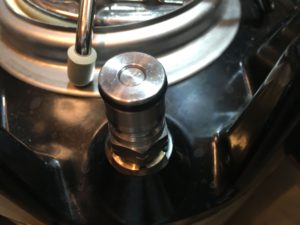 Ball Lock Style Post. Notches on the lower part of the post are an indication that this is an IN/Gas Post. OUT/Liquid Posts do not have these notches.
Ball Lock Style Post. Notches on the lower part of the post are an indication that this is an IN/Gas Post. OUT/Liquid Posts do not have these notches. Ball Lock Style Posts are generally either 11/16″ or 7/8″ and can be tightened and loosened with a regular wrench.
Ball Lock Style Posts are generally either 11/16″ or 7/8″ and can be tightened and loosened with a regular wrench. Pin Lock Style Posts. Notice the… pins.
Pin Lock Style Posts. Notice the… pins.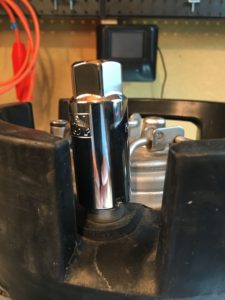 Pin Lock Style Posts require a special notched socket to tighten and loosen the posts.
Pin Lock Style Posts require a special notched socket to tighten and loosen the posts.
More About Post Sizes and Compatible Tools

Sizes to Consider:
When it comes to sizes there are a couple things to think about.
- Wrench size. What size wrench or socket do I need to take off and install keg posts?
- Thread size and count. Depending on manufacturer and model the threads for these posts vary.
Post Wrench Sizes:
Ball Lock Wrench Size
There are two primary post sizes for standard ball lock kegs. 11/16″ and 7/8″. These can come in both 6 point and 12 point, compatible variations. For the larger 7/8″ posts I’ve seen both 6 point and 12 point styles. A 12 point socket will work on a 6 point post, but not vice versa. For the smaller 11/16″ posts I have only seen 6 point. Not to say that 12 point don’t exist, I just don’t recall seeing any. I have seen a couple other sizes – 5/8″ and 9/16″, but I would personally consider those more rare, and non-standard.

This is important from a tool perspective. I recommend a 12 point socket or wrench for larger 7/8″ posts. Smaller 11/16″ post should work with either 6 or 12 point tools.
Pin Lock Lock Wrench Size
I’m aware of one standard size 13/16″. As previously mentioned this requires a special notched socket.
Finding Compatible Tools:
- Keg Sockets – Choose Your Sockets – via Keg Connection – choose from ball lock and pin lock compatible sockets
- Search Amazon for “Pin Lock Socket”
- 11/16″ 6 point: CRAFTSMAN Deep Socket, SAE, 3/8-Inch Drive, 11/16-Inch, 6-Point (CMMT43336) – affiliate link, note that multiple variations of this product may be available, as such a different version may appear at this link
- 11/16″ 12 point: CRAFTSMAN Deep Socket, SAE, 1/2-Inch Drive, 11/16-Inch, 12-Point (CMMT47524) – affiliate link, note that multiple variations of this product may be available, as such a different version may appear at this link
- 7/8″ 12 point: CRAFTSMAN Deep Socket, SAE, 1/2-Inch Drive, 7/8-Inch, 12-Point (CMMT47528) – affiliate link, note that multiple variations of this product may be available, as such a different version may appear at this link
- Hands on Review: Craftsman Deep Well Sockets for Ball Lock Keg Posts
- Hands on Review: “Ball Lock Keg Wrench” – 11/16″+7/8″ Ratcheting Wrench – via Apollo Tools Wrench Set
Homebrew Keg Post Thread Sizes:
Before you purchase any replacement posts for your keg, you’ll need to determine the brand/maker of that keg. You can figure this out by finding the stamp or markings on the side of the keg.
- Cornelius, Ball Lock (all types) GAS 19/32″ – 18 LIQUID 19/32″ – 18 – View +
- Cornelius, Pin Lock (all types) GAS 19/32″ – 18 (2 Pin) LIQUID 19/32″ – 18 (3 Pin) – View +
- Cornelius Spartan 19/32″ – 18 19/32″ – 18 – Shop ++
- Cornelius R (Pin Lock) 19/32″ – 18 (2 Pin) 19/32″ – 18 (3 Pin) – Shop ++
- Firestone V, VI & Super Challanger, Ball Lock* GAS 9/16″ – 18 LIQUID 9/16″ – 18 – View +
- Firestone Challenger, ball lock (racetrack) GAS 11/16″-18 LIQUID 3/4″-18 – +
- Firestone, Pin Lock (all types) GAS 9/16″-18 (2 Pin) LIQUID 9/16″-18 (3 Pin) – View +
- Firestone A (Pin Lock) 9/16″ – 18 (2 Pin) 9/16″ – 18 (3 Pin) – Shop ++
- Firestone R (Pin Lock) 9/16″ – 18 (2 Pin) 9/16″ – 18 (3 Pin) – Shop ++
- Firestone Challenger 11/16″ – 18 3/4″ – 18 – Shop ++
- Firestone Super Challenger 9/16″ – 18 5/8″ – 18 – Shop ++
- Firestone V Challenger 9/16″ – 18 5/8″ – 18 – Shop ++
- Firestone VI Challenger 9/16″ – 18 5/8″ – 18 – Shop ++
- John Wood 85, Ball Lock (racetrack)* GAS 11/16″-18 LIQUID 3/4″-18 +
- John Wood RA or RC, Pin Lock GAS 19/16″-18 (2 Pin) LIQUID19/16″-18 (3 Pin) – +
- John Wood 85 11/16″ – 18 3/4″ – 18 – Shop ++
- John Wood RA (Pin Lock) 9/16″ – 18 (2 Pin) 9/16″ – 18 (3 Pin) – Shop ++
- John Wood RC (Pin Lock) 9/16″ – 18 (2 Pin) 9/16″ – 18 (3 Pin) – Shop ++
- AEB, Ball Lock GAS 19/32″-18 LIQUID 19/32″-18 – View +
- AEB Kegs 19/32″ – 18 19/32″ – 18 – Shop ++
- Super Champion 19/32″ – 18 19/32″ – 18 – Shop ++
* The vast majority (99%) of Firestone Ball Lock Kegs on the market use the same post except for the original Challenger, which had “racetrack” style lids. Racetrack style lids had straight sides like a race track and are rare. All other kegs had standard rounded sides.
+Thank you to Keg Connection for this information – Complete Lineup of Posts and Poppets at Keg Connection
++Thank you to Keg Outlet for this information – Complete Lineup of Posts and Poppets at Keg Connection
 Ball Lock and Pin Lock Quick Disconnects/QDs. Ball Lock on left, Pin Lock on right. I’m guessing these are where these tanks got their names. The Ball Lock QDs have a ball mechanism in them that causes them to lock into place. Where the Pin Lock QDs have notches that lock into place on the pins that are on each post. Notice that Pin Lock QDs are taller than Ball Lock QDs. Grey = gas/CO2/IN, Black = liquid/beer/OUT.
Ball Lock and Pin Lock Quick Disconnects/QDs. Ball Lock on left, Pin Lock on right. I’m guessing these are where these tanks got their names. The Ball Lock QDs have a ball mechanism in them that causes them to lock into place. Where the Pin Lock QDs have notches that lock into place on the pins that are on each post. Notice that Pin Lock QDs are taller than Ball Lock QDs. Grey = gas/CO2/IN, Black = liquid/beer/OUT.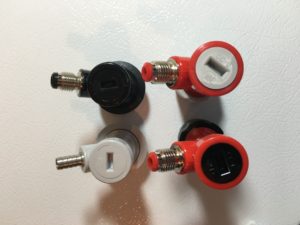 Top down view of Ball and Pin Lock QDs. There are also generally two tubing connection choices. Barbed and MFL. Both are generally 1/4″ Three of these have MFL/Male Flare connections. The bottom left QD has a barb. MFL connections are nice because you can easily remove tubing. Having said that, I prefer barb connections for gas lines. Clamped/barb connections don’t typically loosen up, where flare connections can. It’s easy to notice a leak with a liquid line. If a little beer is leaking, you can tighten up the flare nut. Not so with gas lines. Leaks are invisible. For those I give up a little convenience (Flare) for more security (Barb).
Top down view of Ball and Pin Lock QDs. There are also generally two tubing connection choices. Barbed and MFL. Both are generally 1/4″ Three of these have MFL/Male Flare connections. The bottom left QD has a barb. MFL connections are nice because you can easily remove tubing. Having said that, I prefer barb connections for gas lines. Clamped/barb connections don’t typically loosen up, where flare connections can. It’s easy to notice a leak with a liquid line. If a little beer is leaking, you can tighten up the flare nut. Not so with gas lines. Leaks are invisible. For those I give up a little convenience (Flare) for more security (Barb). This Ball Lock (CMBecker Brand) QD is approximately 2.25″ tall.
This Ball Lock (CMBecker Brand) QD is approximately 2.25″ tall. This Pin Lock (CMBecker Brand) QD is approximately 3.25″ tall. Pin Lock QDs are taller compared with Ball Lock QDs.
This Pin Lock (CMBecker Brand) QD is approximately 3.25″ tall. Pin Lock QDs are taller compared with Ball Lock QDs.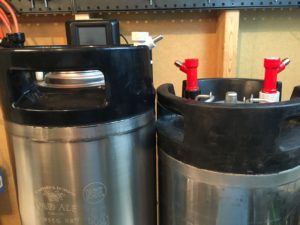 Ball and Pin Lock QDs installed
Ball and Pin Lock QDs installed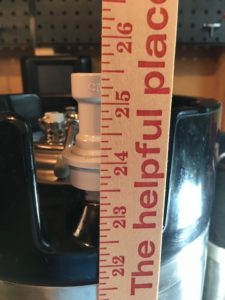 The height of this Ball Lock Keg with CMBecker brand QDs installed is approximately 25.5″
The height of this Ball Lock Keg with CMBecker brand QDs installed is approximately 25.5″ Ball Lock and Pin Lock Quick Disconnects/QDs have the same general components. Screw on cap, o-ring, spring, stem and body. Keg Connection has a nice diagram of parts and has all replacement parts available to order.
Ball Lock and Pin Lock Quick Disconnects/QDs have the same general components. Screw on cap, o-ring, spring, stem and body. Keg Connection has a nice diagram of parts and has all replacement parts available to order.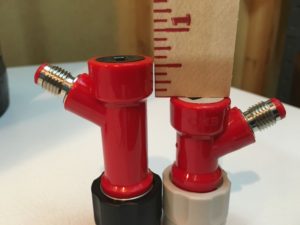 If total height is a concern for your Pin Lock Kegs, a shorter profile QD is available. It is approximately 5/8″ shorter than standard Pin Lock QDs.
If total height is a concern for your Pin Lock Kegs, a shorter profile QD is available. It is approximately 5/8″ shorter than standard Pin Lock QDs.
Rebuilding Ball Lock and Pin Lock Kegs
 The process for Rebuilding Ball Lock and Pin Lock Kegs is nearly identical with one small o-ring related modification for Pin Lock Kegs.
The process for Rebuilding Ball Lock and Pin Lock Kegs is nearly identical with one small o-ring related modification for Pin Lock Kegs.
See: Rebuilding & Reconditioning Homebrew Kegs! – Jump To: Pin Lock Section
They Use the Same Internal QD O-Rings
Both ball lock and pin lock style QDs generally use the same internal o-ring. These o-rings break, become malformed and can easily… get lost.
Internal QD Replacement O-Rings – Food Safe Silicone – via Valuebrew
Pin Lock vs Ball Lock Dimensions
- A 5 gallon Ball Lock keg is about 25″ tall and 8.5″ diameter
- A 5 gallon Pin Lock Keg is about 22-24″ tall and 9″ in diameter
These are guidelines. Actual size varies based on manufacturer and model.
How Many Beers Does a Homebrew Keg Hold?
5 gallons of beer = 640 ounces. That’s just over (53) 12 Ounce Beers or (40) 16 Ounce/Pint Size Beers.
More Common Parts
Both styles also have gas and liquid dip tubes. These may have different dimensions, but the same purpose. Each keg also has a total of 5 o-rings/gaskets. Lid, 2 dip tube o-rings and 2 post o-rings. O-Rings/gaskets are generally interchangeable between ball lock and pin lock style homebrew kegs.
Ball Lock Keg O-Rings vs Pin Lock Keg O-Rings – are they the same?
 Pin Lock Post O-Ring on Left, Ball Lock Post O-Ring on Right
Pin Lock Post O-Ring on Left, Ball Lock Post O-Ring on Right
Standard pin locks and ball locks use identical dip tube o-rings and lid o-rings
Post o-rings are a different story. Standard pin lock keg post o-rings are slightly larger than ball lock keg post o-rings.
 It may be difficult to see in these photos, but the left side shows a pin lock post with a ball lock o-ring installed on it. The right side shows a pin lock post with the pin lock o-ring installed on it. The pin lock o-ring extends out just a little bit further than the ball lock o-ring. The ball lock o-ring is nearly flush the the lip on the post. That small amount is the difference between the two o-rings.
It may be difficult to see in these photos, but the left side shows a pin lock post with a ball lock o-ring installed on it. The right side shows a pin lock post with the pin lock o-ring installed on it. The pin lock o-ring extends out just a little bit further than the ball lock o-ring. The ball lock o-ring is nearly flush the the lip on the post. That small amount is the difference between the two o-rings.
I recommend stocking up on food grade spare o-rings. This is especially true for post o-rings. I recommend you change those liberally. See: Why Won’t My Homebrew Carbonate? Fixing Beer Carbonation Problems – for more information on that.
Buying in bulk means you save money and you’ll have spares when you need them
Food Safe Replacement O-Rings – More Info
THREE Ball Lock Only Accessories
I’m aware of three accessories that, to my knowledge, are available for Ball Lock Kegs, but not available for Pin Lock Kegs. It’s worth noting that when I started this section, there was a single accessory. The list is growing. If you’re on the fence, this may be a tick in favor of ball lock kegs.
#1 Ball Lock Jumper
 Allows you to connect multiple ball lock runs to clean multiple lines and taps at the same time. Works with both liquid and gas QDs. Stainless Steel Ball Lock Jumper – via Valuebrew
Allows you to connect multiple ball lock runs to clean multiple lines and taps at the same time. Works with both liquid and gas QDs. Stainless Steel Ball Lock Jumper – via Valuebrew
#2 Carbonation Caps
Carbonation Caps fit on 1L and 2L size PET Bottles and allow you to pressurize a PET bottle for transporting or preserving the carbonation level of your homebrew (Squeeze out the air in the headspace first to minimize oxygen pickup). You can also use them to quickly carbonate homebrew and fine tune carbonation levels (maybe for competition entry) and… more.
A Pin Lock Carbonation Cap?
No. I’m aware of no pin lock compatible carbonation cap. Beyond that, I’m aware of no DIY Pin Lock Carbonator Cap Build. I’d love that to change. Email me if you have something.
The only thing that’s similar that would work with a Pin Lock Keg is Kent System’s Soda Bottle Cap. That has it’s own connector that would connect to tubing and in turn connect to a Ball Lock or Pin Lock QD.
Ball Lock Carbonation Caps:
- Carbonation and Line Cleaning Ball Lock Cap – via MoreBeer
- Ferroday Stainless Carbonation Cap Counter Pressure Bottle Filling With 5/16″ Barb – Hands on Review
- Stainless Carbonation Cap with 5/16″ Barb Ball Lock Type, Fit Most Soft Drink PET Bottles
- UP100 Line Cleaning Cap Stainless Carbonation Cap Counter Pressure Bottle Filling,w/ 5/16″ Barb
- New offerings regularly pop up. Search Amazon for “stainless steel carbonation cap” to see what’s out there. Again, check descriptions to make sure these work for both gas/grey and liquid/black QDs.
#3 Ball Lock QD with Shank
This ball lock beer connector from Kegland features a shank collar to attach a faucet directly to the ball lock connector. Unlike the previous two ball lock only accessories, this one does have a work around… an MFL QD + Corny Keg Disconnect Faucet Adapter gets you there, albeit not as cleanly.
- Kegland Ball Lock QD with Shank from William’s Brewing
- Kegland Ball Lock QD with Shank from MoreBeer
Thoughts on Ball Lock vs Pin Lock
Ball Lock Kegs have two big advantages in my book – Size and manual PRV. Size – Because Ball Locks have a smaller diameter you can get more of them in most refrigerators or freezers. I can get 4 Ball Locks in my Keezer, but only 3 Pin Locks. Manual PRV – Ball Locks generally feature manual PRV valves which make it easier to vent kegs. A work around for pin locks is to get a depressor.
Advantages to Pin Lock Kegs: Size. Size could also be an advantage depending on what you’re using for a kegerator. Maybe the shorter height is better for your setup. Function – some people swear by pin locks saying they are superior to ball locks. Cost used to be a potential benefit to choosing pin locks, but that’s not the case anymore. Keep reading.
Thoughts on Used Cornys Running Out! and New Kegs
For years we’ve been hearing that supplies of used kegs would be drying up. Up until recently this hasn’t been much of an issue. Although we’ve seen a slow uptick in pricing, kegs were seemingly plentiful and regularly well priced.
I attribute this mostly to the availability of high quality new ball lock kegs. Makers of new kegs upped their game as far as quality and price. To the point where new ball lock keg prices can, at times, be similar to used ball lock keg prices. I think new keg price and quality have helped stave off the disappearance of used kegs. I think the threat was real, but new ball locks helped to stretch out used keg supply
I do believe that bulk quantities of homebrew kegs are dwindling. Along those lines I believe prices will continue to go up and availability will become an issue. This is already true for pin lock kegs. For example, see MoreBeer’s Pin Lock Offering.
See: Are Used Kegs Running Out?
I’m new to Kegging – Which should I choose?
This used to be more of a toss up. But that’s no longer the case.
Considering…
- Price and availability of pin locks
- Ball locks generally have lids with manual PRV valves
- The availability of ball lock only accessories
- The long term availability of ball lock kegs since new kegs are being produced.
I think ball lock kegs are a clear choice. The only reason to consider pin locks, in my opinion, is for size reasons. If the size and shape of your kegerator necessitate pin locks, that’s what you need to do.
If you’re a pin lock user. I think now is the time to stock up.
- Pin Lock Keg (Used) – 5 gallon – at Adventures in Homebrewing
- Set of Four 5 Gallon Kegs, Pin Lock (Used) – at Adventures in Homebrewing
- Pin Lock Keg (Used) – 5 gallon – at Austin Homebrew Supply
- Set of Four 5 Gallon Pin Lock Kegs (USED) – at Austin Homebrew Supply
- Used 5 Gal. Pin Lock Kegs KEG432 – at MoreBeer
- ***SPECIAL*** Tall Pin Lock “Coke Style” Cornelius Keg – or Firestone, 5 Gallon, for Homebrew/Soda | CLEANED – note that these are 1″ taller than standard pin locks
- Pin Lock “Coke Style” Cornelius Keg – or Firestone, 5 Gallon, for Homebrew/Soda, Used | CLEANED
Note that you can also pretty easily use both Pin Lock and Ball Lock kegs. It’s as simple as having lines with each style QD or swapping out QDs.
Keg Deals!
kegdealsKeg Reviews!
Rebuild Your Kegs!
What to Look for When Buying Used Kegs
Buy from a quality supplier that pressure tests kegs and guarantees kegs will hold pressure. Used kegs can come in a variety of conditions, some with soda residue still in them. You’ll definitely want to clean and sanitize the kegs, but also plan on installing new o-rings if your seller hasn’t already done so. Even if they are free of cracks, they will have a soda smell that won’t go away with cleaning.
For a rundown of homebrew keg options and suppliers check out our Homebrew Keg Roundup
https://www.homebrewfinds.com/2012/10/ball-lock-keg-roundup-new-and-used-5.html
Related!
- Food Safe Replacement Keg O-Rings
- Hands On: Brand New, 5 Gallon Keg from AIH
- CMBecker Disconnect Parts List
- Internal QD Replacement O-Rings
- Bulk Keg Orings and Keg Repair Part Numbers
- Shorter Version Pin Lock QDs – these are nice because they reduce total height
- Kegerator Tips & Gear | Recent Keg Finds | Build A Recirculating Draft Line Cleaning Pump | Mark II Keg and Carboy Cleaner Draft Line Cleaning Pump
Finding Compatible Tools:
- Keg Sockets – Choose Your Sockets – via Keg Connection – choose from ball lock and pin lock compatible sockets
- Search Amazon for “Pin Lock Socket”
- 11/16″ 6 point: CRAFTSMAN Deep Socket, SAE, 3/8-Inch Drive, 11/16-Inch, 6-Point (CMMT43336) – affiliate link, note that multiple variations of this product may be available, as such a different version may appear at this link
- 11/16″ 12 point: CRAFTSMAN Deep Socket, SAE, 1/2-Inch Drive, 11/16-Inch, 12-Point (CMMT47524) – affiliate link, note that multiple variations of this product may be available, as such a different version may appear at this link
- 7/8″ 12 point: CRAFTSMAN Deep Socket, SAE, 1/2-Inch Drive, 7/8-Inch, 12-Point (CMMT47528) – affiliate link, note that multiple variations of this product may be available, as such a different version may appear at this link
- Hands on Review: Craftsman Deep Well Sockets for Ball Lock Keg Posts
- Hands on Review: “Ball Lock Keg Wrench” – 11/16″+7/8″ Ratcheting Wrench – via Apollo Tools Wrench Set
More Homebrew Finds!
- Last 50 Finds!
- Top Deals – a curated list of the best deals
- Homebrew Reviews – one of the largest libraries of homebrew reviews in existence!
- Our Top Posts – tips, how-tos, resources posts and more
- Let’s be Friends!
Also: Kegerator Tips & Gear | Keg Repair Part #s | Recent Keg Finds
Our Top Draft Resources
- The Most Difficult Spot to Check for CO2 Leaks
- Keg O-Ring Materials Selection! – EPDM, Silicone and Buna-N?
- Why Do I Have Bubbles in My Beer Line? Diagnosing and Fixing Kegerator Foam Problems
- Five Benefits of Using Corny Kegs As Fermenters
- Rebuilding & Reconditioning Homebrew Kegs!
- Food Safe Replacement Keg O-Rings in Bulk
- Hands on Review: Kegland DuoTight Fittings & EVABarrier Tubing!
- Why Won’t My Homebrew Keg Carbonate? Fixing Draft Beer Carbonation Problems
- What Does a Flow Control Faucet Do?
- Upgrade Your Kegerator – 6 Improvements!
- Serve Homebrew on Any Kegerator & Convert Commercial Kegerator to Homebrew
- Tips and Gear for Growler Filling
- What’s the Difference Between Ball Lock Kegs and Pin Lock Kegs?
- Checking for Draft System CO2 Leaks – Using The Pressure Gauge Method
- Tip: Consider Oetiker Stepless Clamps for Kegerator Gas and Beer Lines
- Hands On Review: Inkbird ITC-308 Dual Stage Temperature Controller +WiFi Version
- Universal Poppets Tips and Tricks!
- Convert Your Mark II Keg & Carboy Washer to a Recirculating Draft Line Cleaning Pump!
- Step by Step: Finding and Fixing Keg CO2 Leaks
- Kegerator Beer Line Temperatures & Reducing Foam with a Recirculating Fan
- Kegging CO2 Use Estimations and Calculations
- Step by Step: Balancing Your Kegerator Draft System
- Building a Simple Ball Lock Draft Line Flushing Setup
- Build a Recirculating Draft Line Cleaning Pump
- Home Brew Keg Roundup – New & Used, 5 and 2.5 Gallon & More!
- Damp Kegerator? Fix Kegerator Condensation
- Portable Draft Beer Serving Options!
- Homebrew Temp Controller Roundup! – Kegerator and Fermentation – concepts, applications and models
- Bulk Keg Orings and Keg Repair Part Numbers
standarddraft pinned
This post may contain affiliate links. We may make a commission when you use our links. This will never cost you extra. Thank you for supporting Homebrew Finds!
greatdealsThis is a Top Post! See: All Top Posts
Make sure the components you use are compatible and rated for your intended application. Contact manufacturer with questions about suitability or a specific application. Always read and follow manufacturer directions. tag:lnksfxd toppost:ballvspinlockkegs rs:7 tag:tpr


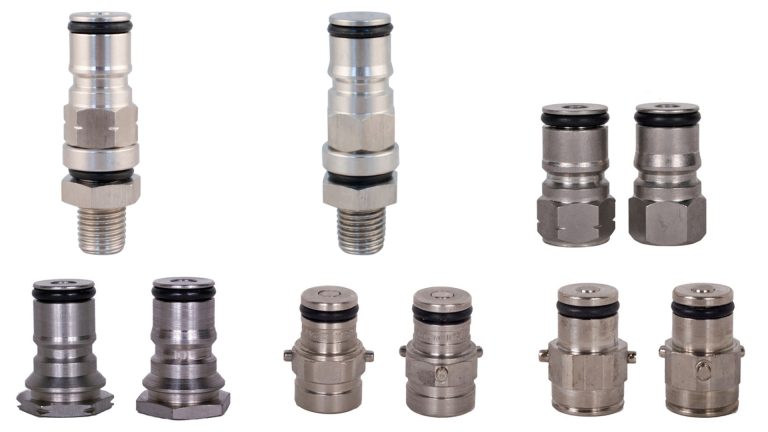




For the 7/8″ Ball Lock I found that a 22mm, 12 point deep socket fits even better than the 7/8″, 12 point socket.
Great review, thanks so much. I didn’t know which way to go, about 20 years ago, and went with pin, which is fine. I never have to worry about which is liquid, and which is gas, as the former is 3 pin, and the latter is 2 pin. Also, for about $20/ea., I bought the PRV caps for my kegs, and I agree, they are handy. Dimensions? I can only fit 2, no matter. How about the many poppet seals, so hard to get the right ones. Thanks again, well done.
In Japan Sanyo Cornelius brand cornies and other local repros are all pinlock dimensions but with ball lock connectors. Coke products are still pinlocks though.
I’m confused, is this line correct: “Pin Lock on left, Ball Lock on Right.”? Based on what I read and what the photo shows, I believe the pin lock is on the right in the photo, is that correct?
If you’re talking about this photo, then the caption is correct the pin lock is on the left and the ball lock is on the right. Pin locks are wider and shorter compared with ball lock kegs.
the height of pinlocks is an advantage. Being several inches shorter I can put 7x 5 gallon plus 2x 3 gallon keg in my keezer… without a collar.
Nice commentary!
I started off with pin lock kegs, then had both for a while, which sucked, choose one or the other. I chose ball lock over pin lock in the end because the pin locks kept popping off when jockeying my tapped kegs around, while the ball locks, once attached, stayed attached.
Great write up! I would add one more thing:
There are some sellers out there selling west they call “low profile ball locks”. In reality, these are just converted pin lock kegs, so the same pin lock keg dimensions and lids are probably still applicable in these cases. I personally think the low profile designation is a bit shady, and probably just a way to try to try to charge a bit more than market for a converted pin lock keg, or at least get more takers.